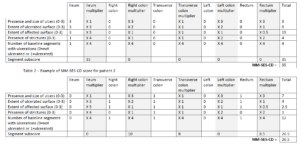Professor El-Omar has chosen Dr Neeraj Narula and Ms Emily Wong to do the next #GUTBlog. Dr Neeraj Narula is Associate Professor of Medicine at McMaster University, Ontario, Canada and Ms Emily Wong is a Research Assistant at the same institution. The #GUTBlog focusses on the latest paper “Predicting endoscopic remission in Crohn’s disease by the modified multiplier SES-CD (MM-SES-CD)” which was published in paper copy in GUT in May 2022.

Ms Wong and Dr Narula write:
“There is no question that advances in endoscopy have dramatically revolutionized the space in disease monitoring for Crohn’s disease. Scoring systems have evolved in response to the need for simplification, which is apparent in the overtaking of the CDEIS, a cumbersome predecessor, by the SES-CD as the gold standard endoscopic score in Crohn’s disease. As evidenced by the SES-CD, simplicity remains the cornerstone to widespread adoption of scoring tools in clinical trials and practice.
The SES-CD considers the ileum and each segment of the colon to have similar prognostic importance, with each of the four sub-scores assigned linearly from 0-3, for a total segment score ranging from 0-12. While the appeal of simplified approaches to endoscopic evaluation is clear, one may ponder on what may be missed from a bird’s-eye view. Notably, different segments may be harder to heal, and elucidating patterns of endoscopic healing may be the key to understanding what is missing. For this reason, our group performed a post-hoc analysis of the SONIC trial, which demonstrated differential rates of endoscopic healing in individual segments, as evaluated using the CDEIS and SES-CD. In particular, patients in SONIC with larger and deep ileal or rectal ulcers had significantly reduced odds of achieving endoscopic remission at the end of the trial (week 26) [1]. This inspired the possibility of individual endoscopic sub-scores holding important prognostic information and provided a foundation for further work in the realm of strictures. We performed another post-hoc analysis using pooled data from three trials and found that patients with non-passable strictures were still able to achieve symptomatic and endoscopic remission on biologics, although not as likely to attain clinical remission compared to those without non-passable strictures [2].
Considering these findings may impact outcomes of patients within clinical trials, we realized there was a need to develop a score to capture the differential prognostic information of each sub-score to ultimately address the differential rates of endoscopic healing we previously observed. The idea of the MM-SES-CD (Modified Multiplier of the SES-CD) was born [3], where the bird’s-eye view was zoomed in and scrutinized to the level of each segment sub-score. The advantage of the MM-SES-CD lies in the ability to capture disease heterogeneity that the SES-CD fails to capture. For instance, patient 1 with very large ulcers of the ileum and mild stenosis that can be passed (Figure 1) but no involvement of the colon would receive a SES-CD score of 10.



Our work on classification of severity suggests that patient 1 has a 13.3% chance of achieving endoscopic remission after one year of biologic therapy, whereas patient 2 has a 30.3% chance [4]. The granularity of endoscopic disease by location and SES-CD components is better captured with the MM-SES-CD, which has numerous implications in trials and practice. Understanding a patient’s predicted likelihood of endoscopic remission while on therapy can identify those who would benefit from treatment modifications or perhaps those at greater risk for surgery. Further, trials could use the MM-SES-CD to ensure adequate balance of endoscopic parameters at baseline.
Admittedly, the MM-SES-CD is a more complicated score at first blush. However, the cost of added complexity is quite small when the intentions of the MM-SES-CD are clarified. The intention was not to necessarily move away from simplicity for the sake of doing so. Rather, the goal was to provide a way to improve the balance of endoscopic parameters between trial arms, using the SES-CD as a basis. Development and internal validation of the MM-SES-CD achieved this goal, with an easy-to-use online calculator freely available (https://www.mcmasteribd.com/mm-ses-cd) that allows trialists to directly convert SES-CD to MM-SES-CD scores.
Certainly, the SES-CD has greatly revolutionized how Crohn’s disease is assessed in trials and in practice, with simplicity being an important consideration. While the MM-SES-CD is still far from routine use in clinical practice, with further validation it remains a possibility. For now, the MM-SES-CD remains in the realm of clinical trials. We are encouraged by the receptiveness of our innovation, and we hope the development of the MM-SES-CD will inspire more innovative research in the field to better prognosticate outcomes for patients.”
References
- Narula, N., et al., Ileal and Rectal Ulcer Size Affects the Ability to Achieve Endoscopic Remission: A Post hoc Analysis of the SONIC Trial.Am J Gastroenterol, 2020. 115(8): p. 1236-1245.
- Narula, N., et al., Outcomes of Passable and Non-passable Strictures in Clinical Trials of Crohn’s Disease: A Post-hoc Analysis.J Crohns Colitis, 2021. 15(10): p. 1649-1657.
- Narula, N., et al., Predicting endoscopic remission in Crohn’s disease by the modified multiplier SES-CD (MM-SES-CD).Gut, 2021.
- Narula, N., et al., Categorizing Endoscopic Severity of Crohn’s Disease Using the Modified Multiplier SES-CD (MM-SES-CD).J Crohns Colitis, 2022.
Social Media
Dr Neeraj Narula @NeerajNarula